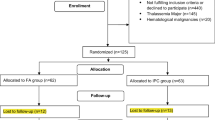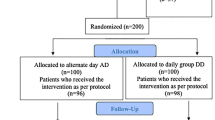Abstract
Objective
To compare the efficacy of ferrous ascorbate and colloidal iron in the treatment of iron deficiency anemia in children.
Methods
Eighty one children, aged 6 mo to 12 y, were screened for iron deficiency anemia (IDA) and those diagnosed with IDA were randomized to receive ferrous ascorbate or colloidal iron for a period of 12 wk, such that each child received elemental iron 3 mg/kg body weight/d. Increase in hemoglobin (Hb) level was the primary outcome measure. Assessment was performed at baseline, wk 4, wk 8 and wk 12.
Results
Of 81 children screened, 73 were included in the study. The mean rise in Hb at the end of the 12 wk was significantly higher in ferrous ascorbate group than the colloidal iron group [3.59 ± 1.67 g/dl vs. 2.43 ± 1.73 g/dl; P < 0.01]. Significantly higher proportion of children receiving ferrous ascorbate (64.86 % vs. 31.03 %; P < 0.01) became non-anemic in comparison to colloidal iron.
Conclusions
Ferrous ascorbate provides a significantly higher rise in hemoglobin levels in comparison to colloidal iron. The study supports the use of ferrous ascorbate in the pediatric age group, providing evidence for its role as an efficient oral iron supplement in the treatment of iron deficiency anemia.

Similar content being viewed by others
References
International Institute for Population Sciences (IIPS) and Macro International. 2007. National Family Health Survey (NFHS-3), 2005–06, India: Key Findings. Mumbai: IIPS. Available from: URL: http://www.measuredhs.com/pubs/pdf/SR128/SR128.pdf. Accessed February 7, 2011.
Gupta R, Gupta RK. Current issues for the prevention of iron deficiency anemia amongst young children. JK Sci. 2004;6:174–5.
Allen LH. Iron supplements: scientific issues concerning efficacy and implications for research and programs. J Nutr. 2002;132:813S–9.
Agarwal MB, Rathi SA. An open label, randomized, comparative clinical study to assess the efficacy and tolerability of ferrous ascorbate versus carbonyl iron in the treatment of iron deficiency anemia. Int J Gynaecol Obstet. 2006;9:13–20.
Wienk KJ, Marx JJ, Santos M, et al. Dietary ascorbic acid raises iron absorption in anaemic rats through enhancing mucosal iron uptake independent of iron solubility in the digesta. Br J Nutr. 1997;77:123–31.
HERS Study Group India. The HERS trial report: a prospective, open label study on efficacy and tolerability of ferrous ascorbate (Ferrous Ascorbate Folic Acid). Int J Gynaecol Obstet. 2005;8:23–30.
Hurrell R. How to ensure adequate iron absorption from iron-fortified food. Nutr Rev. 2002;60:S7–15. discussion S43.
Guinea JM, Lafuente P, Mendizábal A, Pereda A, Sainz Arroniz MR, Pérez Clausell C. Results of preoperative autotransfusion with ferrous ascorbate prophylaxis in orthopedic surgery patients. Sangre (Barc). 1996;41:25–8.
Goddard AF, McIntyre AS, Scott BB, for the British Society of Gastroenterology. Guidelines for the management of iron deficiency anaemia. Gut. 2000;46:iv1–5.
Adamson JW. Iron deficiency and other hypoproliferative anemias. In: Kasper DL, Braunwald E, Fauci AS, Hauser SL, Longo DL, Jameson JL, et al., editors. Harrison’s principles of internal medicine. 16th ed. New York: Health Professions Division; 2005. p. 586–92.
Hallberg L, Rossander L. Improvement of iron nutrition in developing countries: comparison of adding meat, soy protein, ascorbic acid, citric acid, and ferrous sulphate on iron absorption from a simple Latin American-type of meal. Am J Clin Nutr. 1984;39:577–83.
Pizarro F, Uicich R, Olivares M, et al. Iron absorption of ferric glycinate is controlled by iron stores. Nutr Res. 1998;18:3–9.
Hallberg L, Brune M, Rossander L. Low bioavailability of carbonyl iron in man: studies on iron fortification of wheat flour. Am J Clin Nutr. 1986;43:59–67.
Bovell-Benjamin AC, Viteri FE, Allen LH. Iron absorption from ferrous bisglycinate and ferric trisglycinate in whole maize is regulated by iron status. Am J Clin Nutr. 2000;71:1563–9.
Choudhury P, Gera T. Rationale of iron dosage and formulations in under three children. Available from: URL: http://www.idpas.org/pdf/985Rationale.pdf. Accessed January 13, 2011.
Stoltzfus R, Dreyfuss M. Guidelines for the use of iron supplements to prevent and treat iron deficiency anemia. INACG/WHO/UNICEF Report, 1998. Available from: URL: http://www.who.int/nutrition/publications/micronutrients/guidelines_for_Iron_supplementation.pdf. Accessed January 13, 2011.
Guidelines and Protocols Advisory Committee, British Columbia Medical Association. Iron Deficiency-Investigation and Management. Available from: URL: http://www.bcguidelines.ca/gpac/pdf/iron_deficiency.pdf. Accessed January 13, 2011.
Bhargava S, Meurer LN, Jamieson B, Hunter-Smith D. Clinical inquiries. What is appropriate management of iron deficiency for young children? J Fam Pract. 2006;55:629–30.
Acknowledgments
The authors thank Dr. Prashant S Moralwar, the Co-investigator, for assisting in the conduct of this study.
Contributions
VNY was involved in the review of the study protocol, conducting the study in accordance with the standards of GCP, data analysis and revision of the manuscript drafts. BD was involved in the conceptualization of the study, designing of the protocol, initiation, supervision, auditing and monitoring of the site, interpretation of the data and statistical outcomes and revision of the manuscript drafts.
Conflict of Interest
VNY has no financial relationships with Zuventus Healthcare Ltd that might have an interest in the submitted work in the previous 3 y and no other relationships or activities that could appear to have influenced the submitted work.BD is employee of Zuventus Healthcare Ltd.
Role of Funding Source
The financial support for this study was provided by Zuventus Healthcare Ltd including the drugs used in the study: Feronia-XT (Zuventus Healthcare Ltd.) and Tonoferon (East India Pharmaceutical Works Ltd.).
Author information
Authors and Affiliations
Corresponding author
Rights and permissions
About this article
Cite this article
Yewale, V.N., Dewan, B. Treatment of Iron Deficiency Anemia in Children: A Comparative Study of Ferrous Ascorbate and Colloidal Iron. Indian J Pediatr 80, 385–390 (2013). https://doi.org/10.1007/s12098-012-0906-6
Received:
Accepted:
Published:
Issue Date:
DOI: https://doi.org/10.1007/s12098-012-0906-6




